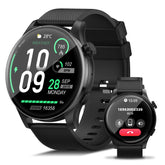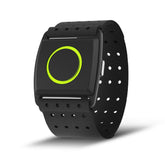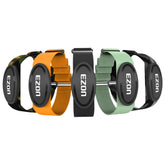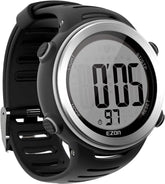Marathon Training Secrets: Heart Rate and Digital Insights for Finishing Strong
Marathon training is a test of endurance, strategy, and self-awareness—and with the right tools, you’ll transform effort into efficiency. This guide reveals how heart rate monitors and digital sports watches unlock marathon training success, from perfecting pacing to preventing injuries. Train smarter, not harder, and cross the finish line strong.
1. The Foundation: Heart Rate Zones for Marathon Mastery
A. Calculate Your Max Heart Rate (MHR)
- Formula: MHR = 220 – age (e.g., 35-year-old = 185 BPM).
-
Key Zones for Marathoners:
- Zone 2 (60–70% MHR): 80% of training for aerobic base (long runs, easy days).
- Zone 3 (70–80% MHR): Tempo runs to boost lactate threshold (race-specific stamina).
- Zone 4 (80–90% MHR): Intervals for speed development (rarely used in marathon prep).
B. The 80/20 Rule: Avoid Overtraining
- Why It Works: 80% easy runs (Zone 2) build endurance without burnout; 20% intensity (Zone 3) improves race pace.
- Heart Rate Monitor Tip: Use real-time alerts to ensure easy runs don’t creep into higher zones—conversational pace (speak in full sentences) is your guide.
2. Pacing: The Marathoner’s Most Critical Skill
A. Race-Day Pacing Strategy
- First 10K: 5–10 seconds slower than goal pace (e.g., 4:30/km goal → 4:40/km start) — your digital sports watch vibrates if you’re too fast.
- Mid-Race (20–30K): Maintain Zone 3 heart rate to avoid the “wall” — check splits to ensure even effort (e.g., 5K splits within 5 seconds of each other).
B. Training with Purpose
- Tempo Runs: 20–30 minutes at 75% MHR (marathon goal pace + 15 seconds/km) to build sustainable speed.
- Progression Runs: Start at Zone 2, gradually increase to Zone 3 over 60 minutes to simulate race fatigue—analyze heart rate recovery post-run (should drop 20 BPM/min).
3. Digital Sports Watch: Your 24/7 Training Partner
A. Real-Time Data for Perfect Execution
- GPS Route Mapping: Preload race courses to know exactly when climbs/downhills hit — adjust effort in advance (e.g., “Steep hill at 18K—save energy”).
- Pace Alerts: Set goal splits (e.g., 4:45/km) and let the watch guide you—critical for negative splits (second half faster than first).
B. Recovery Management
- Training Load Analysis: Cumulative stress scores prevent overtraining (aim for 10–15% weekly increase in mileage).
- Sleep Staging: Ensure 15–20% deep sleep for muscle repair — use watch insights to adjust bedtime (e.g., 10 PM lights-out for 7–9 hours).
C. Injury Prevention Features
- Stride Symmetry: Accelerometer data detects imbalances (e.g., left leg striking 5% harder) — correct with strength training (glute bridges, calf raises).
- Resting Heart Rate (RHR): A 5 BPM increase signals fatigue — swap a hard run for yoga to avoid shin splints or IT band issues.
4. 16-Week Training Plan: From Novice to Finisher
Phase 1: Base Building (Weeks 1–4)
- Goal: Build consistency, 4–5 days/week running.
-
Key Workouts:
- Long Runs: 60–90 minutes at Zone 2, practicing fueling (gel every 45 minutes).
- Cross-Training: Cycling/swimming 1x/week to boost cardio without impact.
- Digital Tool Use: Track weekly mileage with your digital sports watch, ensuring no more than 10% increase.
Phase 2: Intensity & Tempo (Weeks 5–8)
- Goal: Introduce race-specific intensity.
-
Key Workouts:
- Tempo Runs: 2x15 minutes at Zone 3, focusing on form (midfoot strike, relaxed shoulders).
- Hill Repeats: 6x5-minute climbs at Zone 3 to build leg strength — use watch elevation data to measure gradient.
Phase 3: Peak & Taper (Weeks 9–16)
-
Peak Week (Week 12):
- Long run: 32K at goal pace + 30 seconds/km, heart rate steady in Zone 3.
-
Taper (Weeks 13–16):
- Mileage reduction: 30% week-over-week (e.g., 80K → 56K → 39K).
- Watch Insight: Monitor HRV to ensure recovery — high HRV means maintain intensity, low HRV calls for extra rest.
5. Injury Prevention: Listen to Your Body (and Data)
A. Common Injury Triggers & Solutions
| Injury | Warning Sign | Digital Tool Fix |
|---|---|---|
| Shin Splints | Elevated RHR + soreness | Reduce daily steps by 20%, add calf stretches |
| IT Band Syndrome | Stride asymmetry >5% | Correct with hip strengtheners (clamshells) |
| Overtraining | Low HRV + fatigue | Schedule a 5-day recovery week, track RHR daily |
B. Form Checks with Your Watch
- Vertical Oscillation: Aim for <10cm bounce — excessive movement increases knee stress (use accelerometer data post-run).
- Cadence: 170–180 steps/minute reduces impact — set a watch alert if cadence drops below 170.
6. Gear Up for Race Day
A. Heart Rate Monitor Features
-
Chest Strap vs. Wrist-Based:
- Chest straps (e.g., Polar H10) for max accuracy during long runs.
- Wrist-based (EZON Heart Rate Series) for convenience and 24/7 recovery tracking.
B. Digital Sports Watch Essentials
- Multi-Band GPS: EZON GPS Series for accurate tracking in urban canyons (e.g., New York Marathon skyscrapers).
- Battery Life: 40+ hours in GPS mode — no mid-race charging for ultra-distance confidence.
C. Race-Day Gear
- Lightweight Shoes: Test in training to avoid blisters (replace every 300 miles).
- Nutrition Plan: Program gel alerts (every 45 minutes) on your watch to avoid bonking.
7. Race-Day Execution: Trust the Data, Trust Yourself
A. Morning Routine
- Pre-Race Warm-Up: 20-minute easy jog to raise heart rate to Zone 1 — check RHR to ensure you’re calm (should be close to resting).
B. Mid-Race Adjustments
- Heat Management: If heart rate climbs 5 BPM above target, slow pace 5 seconds/km and sip electrolyte drink.
- Fueling Reminder: Follow your watch’s alerts — consistency beats guessing (e.g., 30g carbs every 30 minutes).
C. Finish Strong
- Final 5K: If heart rate is steady, gradually increase pace — your watch’s remaining distance feature helps gauge effort.
8. FAQs: Your Marathon Training Questions Answered
Q: How do I avoid hitting the wall?
- Solution: Practice fueling in every long run (30–60g carbs/hour) and use your heart rate monitor to ensure you’re not overworking early.
Q: Can I train without a heart rate monitor?
- Yes, but with higher risk of over/undertraining. A monitor adds precision, especially for beginners finding their pace.
Q: How to adjust training if I’m always tired?
- Check HRV and RHR — low values mean take 2–3 days off, focusing on sleep and nutrition before resuming.
Train with Insight, Race with Confidence
With heart rate monitors and digital sports watches as your guides, marathon training becomes a science of progress, not pain. Use data to perfect pacing, honor recovery, and listen to your body’s signals, and you’ll cross the finish line not just finished, but thriving.
The marathon is a journey of thousands of steps and heartbeats — let technology be the partner that turns each into a step toward excellence. Gear up, train smart, and let your preparation speak for itself on race day. The finish line is waiting — now go make every heartbeat count.
EZON Watch: Professional sports technology brand
https://ezonwatch.com
https://ezonwatch.com









